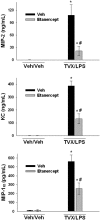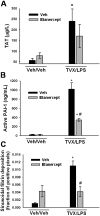Tumor necrosis factor alpha is a proximal mediator of synergistic hepatotoxicity from trovafloxacin/lipopolysaccharide coexposure
- PMID: 18820134
- PMCID: PMC2685899
- DOI: 10.1124/jpet.108.143792
Tumor necrosis factor alpha is a proximal mediator of synergistic hepatotoxicity from trovafloxacin/lipopolysaccharide coexposure
Abstract
The use of trovafloxacin (TVX), a fluoroquinolone antibiotic, was severely restricted because of an association of TVX therapy with idiosyncratic hepatotoxicity in patients. The mechanisms underlying idiosyncratic toxicity are unknown; however, one hypothesis is that an inflammatory stress can render an individual sensitive to the drug. Previously, we reported that treatment of mice with TVX and lipopolysaccharide (LPS) induced tumor necrosis factor (TNF) alpha-dependent liver injury, whereas TVX or LPS treatment alone was nontoxic. The goal of this study was to elucidate the role of TNFalpha in TVX/LPS-induced liver injury. TNF receptor (TNFR) 1 p55(-/-) and TNFR2 (p75(-/-)) mice were protected from hepatotoxicity caused by TVX/LPS coexposure, suggesting that TVX/LPS-induced liver injury requires both TNF receptors. TNFalpha inhibition using etanercept significantly reduced the TVX/LPS-induced increases in the plasma concentrations of several cytokines around the time of onset of liver injury. However, despite the reduction in chemokines, etanercept treatment did not affect the TVX/LPS-induced hepatic accumulation of neutrophils. In addition, etanercept treatment attenuated TVX/LPS induction of plasminogen activator inhibitor-1, and this was associated with a reduction in hepatic fibrin deposition. Mice treated with TVX and a nontoxic dose of TNFalpha also developed liver injury. In summary, TNFalpha acts through p55 and p75 receptors to precipitate an innocuous inflammatory cascade. TVX enhances this cascade, converting it into one that results in hepatocellular injury.
Figures







Similar articles
-
Trovafloxacin enhances the inflammatory response to a Gram-negative or a Gram-positive bacterial stimulus, resulting in neutrophil-dependent liver injury in mice.J Pharmacol Exp Ther. 2009 Jul;330(1):72-8. doi: 10.1124/jpet.109.151068. Epub 2009 Apr 7. J Pharmacol Exp Ther. 2009. PMID: 19351866 Free PMC article.
-
Idiosyncratic drug-induced liver injury and the role of inflammatory stress with an emphasis on an animal model of trovafloxacin hepatotoxicity.Toxicol Sci. 2010 Nov;118(1):7-18. doi: 10.1093/toxsci/kfq168. Epub 2010 Jun 10. Toxicol Sci. 2010. PMID: 20538741 Free PMC article. Review.
-
The role of the hemostatic system in murine liver injury induced by coexposure to lipopolysaccharide and trovafloxacin, a drug with idiosyncratic liability.Toxicol Appl Pharmacol. 2009 May 1;236(3):293-300. doi: 10.1016/j.taap.2009.01.018. Toxicol Appl Pharmacol. 2009. PMID: 19367693
-
Lipopolysaccharide and trovafloxacin coexposure in mice causes idiosyncrasy-like liver injury dependent on tumor necrosis factor-alpha.Toxicol Sci. 2007 Nov;100(1):259-66. doi: 10.1093/toxsci/kfm218. Epub 2007 Aug 19. Toxicol Sci. 2007. PMID: 17709330
-
Comparison of TNFα to lipopolysaccharide as an inflammagen to characterize the idiosyncratic hepatotoxicity potential of drugs: Trovafloxacin as an example.Int J Mol Sci. 2010 Nov 18;11(11):4697-714. doi: 10.3390/ijms11114697. Int J Mol Sci. 2010. PMID: 21151465 Free PMC article.
Cited by
-
Screening for Susceptibility-Related Factors and Biomarkers of Xianling Gubao Capsule-Induced Liver Injury.Front Pharmacol. 2020 May 29;11:810. doi: 10.3389/fphar.2020.00810. eCollection 2020. Front Pharmacol. 2020. PMID: 32547402 Free PMC article.
-
Trovafloxacin enhances the inflammatory response to a Gram-negative or a Gram-positive bacterial stimulus, resulting in neutrophil-dependent liver injury in mice.J Pharmacol Exp Ther. 2009 Jul;330(1):72-8. doi: 10.1124/jpet.109.151068. Epub 2009 Apr 7. J Pharmacol Exp Ther. 2009. PMID: 19351866 Free PMC article.
-
Neutrophil-cytokine interactions in a rat model of sulindac-induced idiosyncratic liver injury.Toxicology. 2011 Dec 18;290(2-3):278-85. doi: 10.1016/j.tox.2011.10.005. Epub 2011 Oct 14. Toxicology. 2011. PMID: 22019926 Free PMC article.
-
Idiosyncratic drug-induced liver injury and the role of inflammatory stress with an emphasis on an animal model of trovafloxacin hepatotoxicity.Toxicol Sci. 2010 Nov;118(1):7-18. doi: 10.1093/toxsci/kfq168. Epub 2010 Jun 10. Toxicol Sci. 2010. PMID: 20538741 Free PMC article. Review.
-
Molecular mechanisms of hepatocellular apoptosis induced by trovafloxacin-tumor necrosis factor-alpha interaction.Toxicol Sci. 2014 Jan;137(1):91-101. doi: 10.1093/toxsci/kft226. Epub 2013 Oct 4. Toxicol Sci. 2014. PMID: 24097668 Free PMC article.
References
-
- Bertino J Jr and Fish D (2000) The safety profile of the fluoroquinolones. Clin Ther 22 798-817; discussion 797. - PubMed
-
- Chen HJ, Bloch KJ, and Maclean JA (2000) Acute eosinophilic hepatitis from trovafloxacin. N Engl J Med 342 359-360. - PubMed
-
- Copple BL, Banes A, Ganey PE, and Roth RA (2002) Endothelial cell injury and fibrin deposition in rat liver after monocrotaline exposure. Toxicol Sci 65 309-318. - PubMed
-
- Dopp JM, Sarafian TA, Spinella FM, Kahn MA, Shau H, and de Vellis J (2002) Expression of the p75 TNF receptor is linked to TNF-induced NFkappaB translocation and oxyradical neutralization in glial cells. Neurochem Res 27 1535-1542. - PubMed
Publication types
MeSH terms
Substances
Grants and funding
LinkOut - more resources
Full Text Sources
Research Materials

